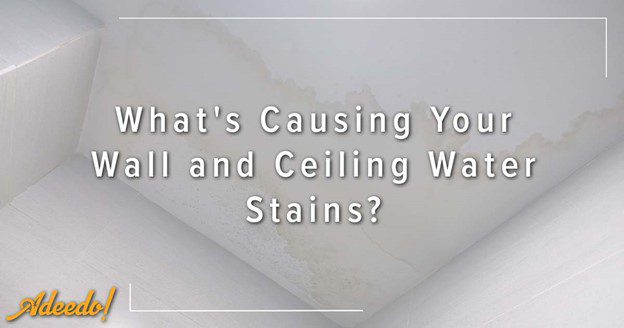Ever walked into a room and noticed a mysterious water stain on your wall or ceiling? Not only are these water stains a visual nuisance, but they can also be a sign of a deeper issue within your home’s infrastructure.
The last thing you need is an expensive plumbing bill. So, let’s figure out what could be causing those stains, how to fix them, and, more importantly, how to prevent them in the future.
What Causes Water Stains?
There are several reasons why water stains appear on your walls and ceilings. Unfortunately, the most common culprits are leaking pipes, faulty plumbing, or an issue with your roof.
Once you’ve noticed water stains on your ceiling, the first thing to do is find the source. Then, hopefully, you can stop it before it causes more damage.
Plumbing Issues
When plumbing goes wrong, like a leaky pipe, a clogged drain, or an overflowing toilet, it can lead to water stains. So as soon as you spot those unsightly marks, it’s essential to check out your plumbing system. Ignoring the problem could lead to a bigger issue down the line.
Start by checking all the visible pipework and plumbing. Look for leaks around sinks, toilets, and showers. Next, check the pipe joints, especially those in the rooms above or next to the position of the water stains.

Roof Leak
If nothing’s wrong with your plumbing, it’s time to turn your eyes to the sky and check out the roof. Perhaps you have a missing slate, or the flashing around your chimney stack needs replacing?
Water finds its way through any nooks and crannies. If your water stains are dark brown, chances are it’s coming from the roof.
Check for leaks by looking for any visible signs of damage or wear and tear, such as cracks, missing shingles, or broken guttering. If you discover a leak, address it immediately to prevent further damage.
Old Piping or Damaged Appliances
It isn’t always pipes or roof leaks that cause wall and ceiling water stains. If your HVAC system is in the attic, it could be the cause of your problem.
When out of sight, it’s easy to forget to check the drip pan, causing it to overflow. Equally, if the unit isn’t draining properly, it can drip through the walls and ceilings, leaving water stains.
Old pipes are also subject to corrosion, causing leaks and drips. A drip here and there may seem insignificant to begin with, but if left, it can cause considerable damage to your home.
Professionals Know Best
Preventing water stains is far more effective than repairing them. Regular roofing and plumbing maintenance is the best way to avoid leaks and water stains.
But if you do find yourself with a problem, call in the professionals. It’ll save you time and stress, and you’re less likely to end up with a more serious problem.
How to Get Rid of Water Stains
The good news is that there are ways to help remove water stains. But only start this process once the leak has been found and fixed. Otherwise, you risk additional staining and structural damage.
Clean the Stain with Bleach
Once you’ve dealt with the cause of the stain, it’s time to start getting rid of the marks. And most households have the perfect cleaner in their cupboards – ordinary bleach.
Mix one cup of bleach with three cups of warm water and wipe over the stain. Not only will this get rid of any lingering mold or bacteria, it’ll also ensure the primer and paint used to cover the stain sticks to the wall or ceiling.
Safety Tip:
Remember to wear gloves and goggles and place an old sheet on the floor to protect the flooring and carpets from bleach drips.
Use a Stain-Resistant Primer
Next up is a primer. As tempting as it is to head straight for the paint, a primer will stop the moisture coming through a water-soluble interior paint. Choosing an oil-based primer in a close shade to the wall or ceiling is best.
It’s Time to Paint
Once you’ve primed the area, it’s ready to paint. If painting a small area, try out some paint samples to find the best match for the rest of your walls or ceiling. Or if the water stain is large, think about a color revamp!
For more severe stains and wall damage, always call a professional to fix your home.
Struggling to get rid of water stains? Get to the root of the problem by calling the Adeedo plumbing professionals. Contact us today and get your home looking new again.

